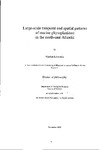Large-scale temporal and spatial patterns of marine phytoplankton in the north-east Atlantic
| dc.contributor.author | Edwards, Martin | |
| dc.contributor.other | School of Biological and Marine Sciences | en_US |
| dc.date.accessioned | 2013-11-04T11:14:28Z | |
| dc.date.available | 2013-11-04T11:14:28Z | |
| dc.date.issued | 2000 | |
| dc.identifier | NOT AVAILABLE | en_US |
| dc.identifier.uri | http://hdl.handle.net/10026.1/2552 | |
| dc.description.abstract |
Phytoplankton constitute the main algal biomass in pelagic ecosystems and, therefore, play a fundamental role in the functioning of the marine trophic web. Information on long-term trends in marine phytoplankton may help to distinguish between biological responses to natural oscillations in climate and global warming, and to evaluate possible regional effects of eutrophication. The aim of this work was to contribute to the general understanding of how phytoplankton are spatio-temporally structured at the large-scale. To achieve this aim, the Continuous Plankton Recorder (CPR) survey data were used to identify the dominant large-scale spatial patterns of phytoplankton in north-western European continental shelf waters. Spatial patterns have been described in relation to their variability in time (seasonal and decadal). Finally, fluctuations of phytoplankton in space and time are described in relation to changes in the environment of the North Atlantic. The analysis included approximately 70,000 samples taken between 1960-1995. The large-scale, spatio-temporal patterns ranged from the meso to the macro-scale (50-10,000 km) and from months to decades. The structure of the thesis follows a progression from the seasonal to the inter-annual scale and from phytoplankton biomass to the phytoplankton community. Particular emphasis is placed on a broad overview of the long-term changes in marine phytoplankton and interpreting anomalous phytoplankton values. Overall, the results suggest that the environment plays a fundamental role in structuring the phytoplankton from the seasonal scale to the decadal scale. The seasonal spatial evolution of phytoplankton shows close associations to the hydrography of the north-east Atlantic, from the overall biomass to the timing and ending of the seasonal growth period. At larger-scales, atmospheric forcing (principally governed by the North Atlantic Oscillation index) has a dominant effect on decadal variability of phytoplankton populations in the north-east Atlantic. Although there is considerable regional variability in the long-term trends in phytoplankton biomass and community structure, underlying patterns emerged to reveal common trends. During the last decade, there has been a considerable increase in phytoplankton bion1ass in most regions (particularly the North Sea) and an increase in the dominance of dinoflagellates amongst the phytoplankton community, while the opposite pattern was observed for the northern oceanic area of the north-east Atlantic. These different spatial responses show similar patterns to changes in the decadal variability of sea-surface temperature influenced by the North Atlantic Oscillation index. While atmospheric variability plays a key role in the overall long-term and regional patterns of phytoplankton, oceanic influences on the North Sea ecosystem have been underestimated in the past. The anomalous phytoplankton biomass values, and large community shifts in the North Sea, are associated with episodic hydrographic events seen during the late 1970s/early 1980s and the late 1980s/early 1990s. It is suggested that these hydrographic events conspire to produce anomalous ocean climate conditions in the North Sea which persist for a number of years and are significant enough to alter the overall ecology of the North Sea. | en_US |
| dc.description.sponsorship | Sir Alister Hardy Foundation for Ocean Science | en_US |
| dc.language.iso | en | en_US |
| dc.publisher | University of Plymouth | en_US |
| dc.title | Large-scale temporal and spatial patterns of marine phytoplankton in the north-east Atlantic | en_US |
| dc.type | Thesis | |
| plymouth.version | Full version: final and full version as approved by the examiners at the time of the award of your degree | en_US |
| dc.identifier.doi | http://dx.doi.org/10.24382/3862 | |
| dc.identifier.doi | http://dx.doi.org/10.24382/3862 |
Files in this item
This item appears in the following Collection(s)
-
01 Research Theses Main Collection
Research Theses Main


